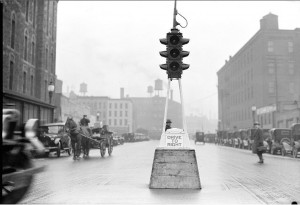
The first traffic light appeared in Cleveland 100 years ago this week. Early models didn't have a yellow light. Photo Credit: Broadstreet Corridor.
If you’ve just finished a frustrating commute crawling through traffic, imagine how much worse your daily drive might be without some roadway essentials, like lane markers, speed limit signs – and the traffic light.
Red, yellow, green, those three colors have become a ubiquitous part of our modern lives, but it wasn’t always that way. In fact, the first electric traffic light didn’t make its appearance until nearly a year after Henry Ford switched on the world’s first moving assembly line. As with many breakthroughs, there are plenty of conflicting claims, but historians generally agree that the first true stoplight was installed on the corner of Euclid and 105th in Cleveland 100 years ago this week.
Back then, Cleveland was a bustling and fast-growing metropolis, and second only to Detroit in terms of automotive production. So, its roads were approaching gridlock when Ohio inventor James Hoge came up with his clever idea: the first stoplights produced by the American Traffic Signal Company.
Today’s motorists might not even recognize the Municipal Traffic Control System, as Hoge dubbed his device. There was no yellow warning, just red and green lights mounted on each corner, along with swing-arm stop-and-go indicators. And it still took a policeman or some other operator, working a switch inside a control booth, to operate the contraption. But it quickly helped bring the flood of traffic under control.
Hoge actually filed his patent request in September 1913, but it took nearly a year to get a working model built – and he didn’t receive his patent, number 1251666, until January 1918.
The fact that an officer still needed to operate the contraption meant it had serious limitations, notes Hemmings Motor News. The classic car publication tracked photos from the 1920s that show the Hoge system had been pulled from the busy intersection and an officer was back on the street directing traffic.
So, if the American Traffic Signal Company didn’t really get it right, who did? One possibility is Lester Wire, a police detective from Salt Lake City, who painted a birdhouse yellow, then drilled some additional holes for red and green lightbulbs. It was operating in the city by 1912 – but while it did away with the swing arms, it still required someone to operate a switch to control the lights.
For reasons long debated, Wire never patented his device and his role in automotive history is uncertain. It took a court fight for another police officer, Detroit’s William L. Potts, to get credit for inventing the first traffic light to use the now-familiar combination of Red-Yellow-Green bulbs. First installed at the intersection of Woodward and Michigan avenues, the system initially also had to be operated manually, though by 1921 Potts figured out a way to automate his invention – which quickly caught on in the Motor City.
(To get insights into TDB’s first drive in the 2015 Acura TLX, Click Here.)
A year later, Garrett Morgan, another Cleveland resident, filed for a patent on an electrically lit T-shaped signal that operated more like the semaphores widely used by railroads. He eventually sold his patent to General Electric, which quickly became a major manufacturer of stoplight systems.
(Bernie Ecclestone buys his way to freedom with $100 million. For more, Click Here.)
A number of different designs were used in the early years, some popping up signs to make sure motorists came to a “Stop” when the light changed to red. And while the yellow warning was first seen in the ‘20s, many streetlights in cities as big as New York continued to use only red and green lights into the 1960s.
(And today, not all signals around the world operate the same way. Europeans get a warning when the light is about to go green as both the yellow and red bulbs light simultaneously.)
(Click Here for details on what kind of car you can buy for $1 million.)
These days, stoplights are seemingly everywhere, only the most rural communities still without them. But the basic technology is rapidly evolving. In many communities, sensors track traffic at busier intersections, and computer software can adjust their timing to improve traffic flow. Los Angeles recently created a citywide smart network designed to minimize the number of red lights motorists run into during their commutes.
And even bigger changes could come in the decades ahead. Federal regulators may soon enact mandates requiring so-called connected car technology that would allow vehicles to talk to one another, and to a roadway infrastructure. And with autonomous vehicles expected to go into production by 2020 – and to become commonplace by 2035, according to a study by Navigant Research – stoplights may no longer be necessary, as vehicles would automatically signal one another when it was safe to pass through an intersection.

Tops on the list of possibly apocryphal but certainly quirky stories of early traffic light days: Boston neighborhoods so heavily infested with Irish that rock-throwing at the lights only stopped when the green color was moved to the top.
Why did you use a word that we need to look up? Couldn’t you say anecdote? It would have conveyed the same message
Gee, maybe because the words aren’t synonyms, although perhaps saying that only clouds the issue further.
The two words are neither the same part of speech, nor synonymous. An anecdote (noun) might be apocryphal (adjective), but might also be verifiable.
“Apocryphal” is an efficient (and relatively common) way to acknowledge an oft-told anecdote is probably untrue.